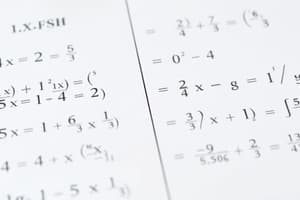Podcast
Questions and Answers
What is the general form of a quadratic equation?
What is the general form of a quadratic equation?
- _ax^2 + bx + c_ (correct)
- _ax + bx^2 + c_
- _ax^3 + bx + c_
- _a + bx + cx^2_
Which method involves transforming a quadratic equation into the form a(x - k)^2 + d?
Which method involves transforming a quadratic equation into the form a(x - k)^2 + d?
- Using the quadratic formula
- Factoring
- Completing the square (correct)
- Graphing quadratic functions
What does a positive value of parameter 'a' signify in a quadratic function?
What does a positive value of parameter 'a' signify in a quadratic function?
- The parabola opens upwards (correct)
- The parabola opens downwards
- The parabola is horizontal
- The parabola is vertical
Which term represents the solutions or roots of a quadratic equation when it is factored as a(x - p)(x - q)?
Which term represents the solutions or roots of a quadratic equation when it is factored as a(x - p)(x - q)?
What is the formula used to find solutions to non-factorable quadratic equations?
What is the formula used to find solutions to non-factorable quadratic equations?
In graphing a quadratic function, what shape does a parabola exhibit when 'a' is negative?
In graphing a quadratic function, what shape does a parabola exhibit when 'a' is negative?
Where do the highest and lowest points on a parabolic graph, known as the vertex, occur?
Where do the highest and lowest points on a parabolic graph, known as the vertex, occur?
What type of values does a parabola open upwards have at its vertex?
What type of values does a parabola open upwards have at its vertex?
For quadratic expressions with repeated roots, what is the characteristic of the roots in the solution?
For quadratic expressions with repeated roots, what is the characteristic of the roots in the solution?
In quadratic expressions like a(x - p)(x - q), how is finding the solutions affected?
In quadratic expressions like a(x - p)(x - q), how is finding the solutions affected?
For quadratic expressions with two identical roots, where is the double root located?
For quadratic expressions with two identical roots, where is the double root located?
How do quadratic equations contribute to understanding more complex mathematics?
How do quadratic equations contribute to understanding more complex mathematics?
Flashcards are hidden until you start studying
Study Notes
Algebra: Exploring Quadratic Equations
Quadratic equations, a fundamental concept in algebra, represent a class of expressions that take the form of ax^2 + bx + c, where (a), (b), and (c) are real numbers, and (x) is a variable. These equations often describe real-world scenarios, such as projectile motion, population growth, and more.
Uncovering Solutions
The most common approach to solving quadratic equations involves factoring, completing the square, or using the quadratic formula.
-
Factoring: By finding two binomials that multiply to ac and add to b, you can express the quadratic as a(x - p)(x - q), where (p) and (q) are called roots or solutions.
-
Completing the square: By adding and subtracting a suitable term, you can transform the quadratic into the form a(x - k)^2 + d, after which you can find the solutions by taking the square root of the expression inside the parentheses.
-
Quadratic formula: This formula, x = (-b ± √(b^2 - 4ac))/2a, is a general solution for quadratic equations regardless of whether they are factorable or not.
Applications and Properties
-
Graphing quadratic functions: An equation of the form y = ax^2 + bx + c represents a parabola. The parabola opens upwards if (a) is positive, downwards if (a) is negative, and is either horizontal or vertical if (a) is zero.
-
Maxima and minima: The highest and lowest points on a parabolic graph, called the vertex, occur at the value of (x) that satisfies the equation x = -b/2a. The corresponding (y)-coordinate of the vertex is f(-b/2a).
-
Bounding values: If the parabola opens upwards, the maximum value of the function occurs at the vertex; if it opens downwards, the minimum value occurs at the vertex.
Investigating Special Cases
-
Linear factors: Quadratic expressions with linear factors, such as a(x - p)(x - q), are easily factored, making it straightforward to find the solutions.
-
Repeated roots: Quadratic expressions with the same linear factor twice, such as a(x - p)^2, have a single root that appears twice in the solution.
-
Double roots: Quadratic expressions with two identical roots, such as a(x - p)^2 + b, have a double root at (x = p).
Paving the Way for More Complex Mathematics
Quadratic equations pave the way for more complex mathematics, including the study of systems of equations, inequalities, and polynomials of higher degree. Additionally, they are a fundamental tool in various subjects, such as physics, engineering, and economics.
In short, understanding quadratic equations is essential for mastering algebra, preparing for more advanced mathematical topics, and tackling real-world problems.
Studying That Suits You
Use AI to generate personalized quizzes and flashcards to suit your learning preferences.



